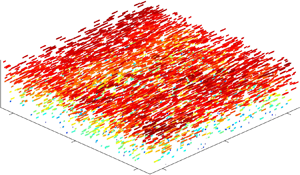Article contents
A direct comparison of turbulence in drag-reduced flows of polymers and surfactants
Published online by Cambridge University Press: 21 April 2021
Abstract

We experimentally compared the drag-reduced turbulent channel flow of three different additives: a flexible polymer, a rigid polymer and a surfactant. A high drag reduction (HDR) of approximately 58 % was achieved using the flexible polymer, the rigid polymer and the surfactant. A maximum drag reduction (MDR) of approximately 70 % was also achieved using the flexible polymer and the surfactant. Solutions of flexible polymer and surfactant had a small shear viscosity, while the rigid polymer solution had a large shear viscosity with a considerable shear-thinning behaviour. The flexible polymer solution was the only fluid to exhibit a large extensional relaxation time. At HDR, the wall-normal distribution of mean velocity and the turbulent statistics of the drag-reduced flows were a function of the additive type and Reynolds number, Re. At MDR, the wall-normal distribution of mean velocity and turbulent statistics of the drag-reduced flows were similar, and not contingent on the additive type or Re. Due to its larger shear viscosity, the rigid polymer solution did not reach the MDR state in terms of drag reduction and mean velocity profile. However, the Reynolds stress profiles and turbulent length scale of the rigid polymer solution at HDR were similar to those of the flexible polymer and surfactant solutions at MDR. Our investigation demonstrated that different additives generate drag-reduced flows with similar turbulent statistics; however, no common rheological feature has been identified as of yet.
JFM classification
- Type
- JFM Papers
- Information
- Copyright
- © The Author(s), 2021. Published by Cambridge University Press
References
- 16
- Cited by



